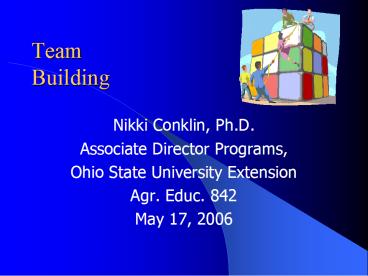Team Building - PowerPoint PPT Presentation
1 / 23
Title:
Team Building
Description:
Team. Building. Nikki Conklin, Ph.D. Associate Director Programs, Ohio State University Extension ... Team is a group of people who work together to achieve a ... – PowerPoint PPT presentation
Number of Views:151
Avg rating:3.0/5.0
Title: Team Building
1
Team Building
- Nikki Conklin, Ph.D.
- Associate Director Programs,
- Ohio State University Extension
- Agr. Educ. 842
- May 17, 2006
2
Teams
- Team is a group of people who work together to
achieve a desired outcome - People become a team when they work together
interdependently and synergistically to
accomplish something. - (Wellins, Byham Wilson, 1991)
- Teamwork is a series of complementary and
mutually reinforcing behaviors completed in a
group (Snow, 1992)
3
Why Teams
- Use of teams increased dramatically in all
organizations in the last decade - Teams are an appropriate structure for
implementing strategies formulated to deal with
performance demands and opportunities presented
by the changing business environment. - (Mohrman, Cohen Mohrman, 1995)
4
Why Teams Cont.
- Teams are recognized as a fit between strategy
and organizational design which leads to a
competitive advantage - .
- Galbraith, Lawler and Associates, 1993 Nadler,
Gerstein, Shaw and Associates 1992)
5
Purpose of Teambuilding
- Teambuilding is designed to help people who work
together to function more effectively in teams
and to assist the team itself to work more
effectively as a whole - (Moxon, 1993)
6
Team Building
- Teambuilding can be defined as a structured
attempt to improve/develop effectiveness of a
group of people who work together - (Clark, 1994, Moxon,1993)
- Each team member should have a notion of constant
improvement in order for a company or team to
continually improve - (Byham,1990)
7
Teambuilding
- A deliberate process of facilitating the
evolution of a close and effective work group so
that - Team leadership is coherent, visionary and
acceptable - The teams roles, functions and deliverables are
clearly understood - Members of the team have emotionally signed up
and dedicated their efforts to collective
achievement - There is positive, energetic and empowering
climate in the work group - Informal and formal meetings are efficient and
make good use of time and available resources - Weaknesses in team capability have been diagnosed
and their negative effects mitigated or
eliminated (Woodcock Francis, 1994)
8
Teambuilding
- The best teambuilding happens when selected
activities meet identified needs of the team or
address as needed skills and competencies. - Teambuilding in a workplace is a task-oriented
activity. The task alone provides the context in
which it becomes appropriate to discuss processes
and procedures and individual behavior - (Moxon, 1993)
9
Teams
- Teams can allow organizations to be more
responsive in dealing with new demands and
opportunities in a rapidly changing world. - Allow for organizational flexibility
- Integration of knowledge , experience and
perspective that cannot be held by one person.
(Donnellon, 1996)
10
Effective Teams
- Effective teams are self-directed and are made up
of small groups of people empowered to manage
themselves and the work they do on a daily
basis. (Wellins, Byuham Wilson, 1991)
11
Types of Teams
- Employee involvement meets on a regular basis
to use its talents to help solve problems
achieve continuous improvement (quality circles) - (Schermerhorn, 2002)
12
Types of Teams
- Committees formal team designated to work on a
special task on a continuing basis. - Project team / task force formal team convened
for a specific purpose expected to disband when
that purpose is achieved. - (Schermerhorn, 2002)
13
Types of Teams
- Cross-functional task group staffed with a mix
of specialists pursuing a common objective. - Virtual task group members from dispersed
locations who are electronically linked. - (Kreitner, 2001)
14
Characteristics of Effective Teams
- Team leadership
- Team direction
- Information
- Team processes
- Clear roles and responsibilities
- Adequate resources
- Physical
- Human
- Financial
15
Managers Role on Teams
(Schermerhorn, 2002)
16
Empowering Teams
- Clear charge and boundaries for work
- Skilled team leaders
- Safe environment
- Strategies to manage conflict
- Freedom to work
- Performance measurement with feedback
- Compensation and rewards
17
Trust
- Belief in the integrity, character, or ability of
others. - (Kreitner, 2001)
18
Building Trust
- Concentrate on six areas
- Communication
- Support
- Respect
- Fairness
- Predictability
- Competence
- (Kreitner, 2001)
19
(No Transcript)
20
Indicators of success for program teams in the
Cooperative Extension System
- Kelbaugh (2003) dissertation research in HCRD
- Delphi with Extension professionals nationally
- Identified 4 indicators as critically important
to program team success
21
Critically important indicators(Kelbaugh,2003)
- Evidence that team members are committed to the
work of the team and follow through with their
agreed upon roles and responsibilities - A clear vision of where the team is going, and
agreed upon and understood goals - The impact of programs delivered to clientele
- An established process for communication among
team members that allows for efficient and open
information sharing in a timely manner
22
Building Blocks for Teams
- Resources for Team Leaders
- OSU Extension
- http//www.ag.ohio-state.edu/ptd/index.html
23
References
- Kreitner, R. (2001). Management (8th Ed.).
Boston Houghton Mifflin Co. - Schermerhorn, J.R. (2002). Management (7th
Ed.). New York John Wiley Sons, Inc. - Tuckman, B.W. Jensen, M.A.C. (1977). Stages of
small-group development revisited. Group and
Organization Studies, 2(4), 419-427.































